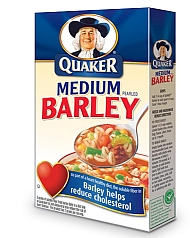Beef Barley Soup
First Release: 16-Nov-10
The key to making good soup is to start with a well-made stock. To do
that you'll need to boil a bone-in piece of meat for several hours to release
the collagens. For best results make the stock the day ahead of the soup
to allow time for cooling to remove excess fat. (This applies to chicken
and other kinds of stock as well. Some people even break up the bones
and... well, I'm getting ahead of myself).
The Stock
2 lbs of beef spare ribs or neckbones with meat on them
1 large onion, quartered
1 bay leaf
six peppercorns
1 clove of garlic, minced
1/2 cup fresh parsley, finely chopped
(more ingredients are listed below for the soup) |

Ok, this isn't an actual photo of one of our soups. It is just a 'stock'
photo. Ha - couldn't resist! |
Place ingredients above in a large Dutch oven or stockpot. (If you
don't see a lot of exposed bone marrow you could break the bones into several
pieces for better flavor) Add enough water to cover the meat, which should
amount to at least four quarts and perhaps six or more. Bring to a low
boil, then reduce heat to medium to maintain a low simmer. Skim the top
when needed to remove scum. Simmer uncovered for six to eight hours,
replenishing with hot water as needed to keep all ingredients submerged.
Remove the bone(s), strip and reserve any pieces of meat that are large enough
and gristle-free and put them back into the stock. Remove large onion
pieces if you find them unsightly otherwise leave them in. Cover and cool
the stock immediately by either putting it into a large cooler of ice or if you
live in a cold environment (like ours) you can put it outside if it is well
below 40°F out. The main thing is to cool it quickly so the temperature of
the stock is only briefly in the 'danger' temperature zone of 40-140°F. We
put ours outside on our concrete steps when it is 25-35 degrees outside (with
the cover on, of course). Place in refrigerator as needed to continue
cooling, perhaps overnight if needed for the fat to come to the top and
solidify. Break the solidified fat into pieces large enough to easily hold
and remove them. The stock can then be stored in a refrigerator for
several days or in a freezer for several months if desired.
The Soup
1lb stew meat
1T cooking oil
1/2 cup of flour (optional, as noted below, for a thicker stew-like
soup)
Three large or four medium carrots, peeled and chopped into 1/2" lengths
One large onion, chopped into 1/4" or smaller pieces
two stalks of celery, sliced into 1/4" lengths
Three quarts of the beef stock or use it up if desired
1/2 cup of medium pearled barley
28 oz container of "store-bought" beef stock - optional, see below
Beef "better than bouillon" or bouillon cubes to taste - optional, see
below |
 |
If you're not sure how much barley you'll need you can make it separately by
following package directions but substituting the beef stock for some of the
water. It can cook while you're doing the rest as follows.
Put the beef stock in a large Dutch oven or stockpot, bring to boil for a few
minutes, then turn down until it simmers. Cut the stew meat into 1/2"
cubes (it helps to start with slightly frozen meat), brown in frying pan with
cooking oil until medium-rare (check the inside of one piece occasionally).
For thicker soup you can coat the meat pieces in flour by shaking them in a
quart-sized zip lock before browning. Once the meat is done browning add
it to the stock. Deglaze the pan by first removing all loose chunks of
browned meat, raise the heat under the frying pan to high until any coating on
the bottom of the pan just turns dry. Turn vent fan on high, then quickly add
about 1/8 to 1/4 cup of cold water to the pan to create steam and loosen the dry
part from the bottom. Quickly scrape the pan with the flat edge of a
spatula to remove the browned part and add it to the simmering soup.
Repeat as needed to loosen the browned part (and also help to clean the pan!).
Using flour to coat the meat will result in more bottom-scrapings. Get the
pan just hot enough to dry the bottom a bit before deglazing - don't let it
burn. Well, if it burns a bit, taste it and decide if it is still usable
before discarding. (We use the browned parts even if they are heading
toward dark, dark brown).
Depending on how tough the stew meat is you may need to let it simmer in the
stock for an hour before performing the following steps. If you don't mind
your beef chunks to be a bit chewy, charge on...
Place the carrots, onion and celery into stock stock, bring it to a boil for at
least two minutes, then turn to medium or low to keep it at a simmer.
Cover the soup and let it simmer for an hour, stirring occasionally, checking
vegetables for desired cooked texture (I like the carrots to be firm but not
crunchy). Remove bay leaf. Add cooked barley as desired just before
serving. Now, if you're good with barley, and someday I hope to be, you
could cook the barley along with the vegetables until done, making sure to raise
it to a boil first. Like rice, the barley will absorb a lot of liquid so I
prefer to cook it separately so I can keep the thickness of the soup to my
liking without having to add water (which would dilute the flavors) or add extra
store-bought broth or bouillon (which ought to be unnecessary). Serves
8-10 Midwesterners.

